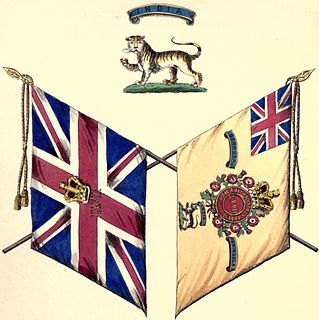Related Research Articles

The Cheshire Regiment was a line infantry regiment of the British Army, part of the Prince of Wales' Division. The 22nd Regiment of Foot was raised by the Duke of Norfolk in 1689 and was able to boast an independent existence of over 300 years. The regiment was expanded in 1881 as part of the Childers Reforms by the linking of the 22nd (Cheshire) Regiment of Foot and the militia and rifle volunteers of Cheshire. The title 22nd (Cheshire) Regiment continued to be used within the regiment.
The 28th Regiment of Foot was a line infantry regiment of the British Army, raised in 1694. Under the Childers Reforms it amalgamated with the 61st Regiment of Foot to form the Gloucestershire Regiment in 1881.
The 77th Regiment of Foot was a Highland Scots Regiment raised in 1757. The 77th Regiment was one of the first three Highland Regiments to fight in North America. During the Seven Years' War, the regiment lost 110 soldiers and 259 were wounded.

The 55th Regiment of Foot was a British Army infantry regiment, raised in 1755. After 1782 it had a county designation added, becoming known as the 55th (Westmorland) Regiment of Foot. Under the Childers Reforms it amalgamated with the 34th (Cumberland) Regiment of Foot to form the Border Regiment in 1881.
The 38th Regiment of Foot was an infantry regiment of the British Army, raised in 1705. Under the Childers Reforms it amalgamated with the 80th Regiment of Foot to form the South Staffordshire Regiment in 1881.

The 45th (Nottinghamshire) Regiment of Foot was a British Army line infantry regiment, raised in 1741. The regiment saw action during Father Le Loutre's War, the French and Indian War and the American Revolutionary War as well as the Peninsular War, the First Anglo-Burmese War and the Xhosa Wars. Under the Childers Reforms it amalgamated with the 95th (Derbyshire) Regiment of Foot to form the Sherwood Foresters in 1881.
The 37th Regiment of Foot was a line infantry regiment of the British Army, raised in Ireland in February 1702. Under the Childers Reforms it amalgamated with the 67th Regiment of Foot to become the Hampshire Regiment in 1881.

The 67th Regiment of Foot was a line infantry regiment of the British Army, raised in 1756. Under the Childers Reforms it amalgamated with the 37th Regiment of Foot to form the Hampshire Regiment in 1881.
The 66th (Berkshire) Regiment of Foot was an infantry regiment of the British Army, raised in 1756. Under the Childers Reforms it amalgamated with the 49th (Hertfordshire) Regiment of Foot to form the Princess Charlotte of Wales's in 1881.
The 69th Regiment of Foot was an infantry regiment of the British Army, raised in 1756. Under the Childers Reforms it amalgamated with the 41st (Welch) Regiment of Foot to form the Welch Regiment in 1881.
The 61st Regiment of Foot was an infantry regiment of the British Army, raised in 1756. Under the Childers Reforms it amalgamated with the 28th Regiment of Foot to form the Gloucestershire Regiment in 1881.

The 30th (Cambridgeshire) Regiment of Foot was an infantry regiment of the British Army, raised in 1702. Under the Childers Reforms it amalgamated with the 59th Regiment of Foot to form the East Lancashire Regiment in 1881.
The 74th Regiment of Foot was an infantry regiment of the British Army from 1758 to 1763.
The 100th Regiment of Foot, also known as Campbell's Highlanders, was an infantry regiment of the British Army, formed in 1760 and disbanded in 1763.
The 48th (Northamptonshire) Regiment of Foot was a regiment of the British Army, raised in 1741. Under the Childers Reforms it amalgamated with the 58th (Rutlandshire) Regiment of Foot to form the Northamptonshire Regiment in 1881.
The 108th Regiment of Foot was an infantry regiment of the British Army from 1761 to 1763. It was raised in October 1761 from a cadre of the 31st Regiment of Foot, and was disbanded in 1763.
The 95th Regiment of Foot (Burton's) was an infantry rifle regiment of the British Army.
The 76th Regiment of Foot was a regiment of the British Army from 1756 to 1763.
The 73rd Regiment of Foot was a regiment in the British Army from 1758 to 1763. It was formed on 28 April 1758 from the 2nd Battalion of the 34th Regiment of Foot, and served in Ireland until it was disbanded in 1763.
The 83rd Regiment of Foot (1757–1763) was a short-lived infantry regiment in the British Army which was raised in Ireland in 1757 to counter the Spanish Invasion of Portugal of 1762, an offshoot of the Seven Years' War.
References
- ↑ "75th Regiment of Foot". regiments.org. Archived from the original on 23 October 2007. Retrieved 9 May 2017.